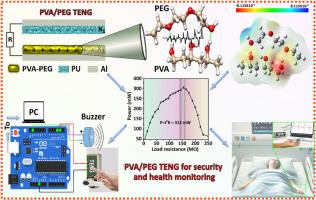High-performance tribopositive PEG-PVA blends for smart energy harvesting: A pathway to self-powered security and healthcare monitoring
IF 9.8
1区 材料科学
Q1 MATERIALS SCIENCE, COMPOSITES
引用次数: 0
Abstract
The development of efficient and sustainable materials for triboelectric nanogenerators (TENGs) is critical for advancing self-powered technologies. In this study, a novel tribopositive polymer composite of polyethylene glycol (PEG) and polyvinyl alcohol (PVA) is introduced to fabricate high-performance TENGs. The incorporation of PEG in varying quantities of (0.1, 0.2, 0.4, 0.6, 0.8, 1.0, and 1.2 g) introduces additional polar functional groups (-OH), forming a robust hydrogen-bonding network with PVA and creating abundant charge interaction sites, which was confirmed through the DFT calculations. Systematic investigations of the PEG-to-PVA ratio reveal a significant improvement in triboelectric output, achieving an output voltage of 426.52 V and 82.65 μA. The practicality of the PVA/PEG-TENG is demonstrated through its ability to energize small electronic devices, including smartwatch, a sequence of LEDs and commercial capacitors. Additionally, the device is successfully integrated into a door security system, showcasing its potential for real-time security applications. Further, the tactile movement detection of bedridden or comatose patients is monitored using the PVA/PEG-TENG, highlighting its potential in healthcare applications. This study establishes the PEG-PVA composite as a promising material for versatile, high-performance, and sustainable energy-harvesting systems.

用于智能能量收集的高性能摩擦正聚乙二醇-聚乙烯醇混合物:实现自供电安全和医疗保健监控的途径
开发高效、可持续的摩擦纳米发电机材料对于推进自供电技术至关重要。本研究介绍了一种新型的聚乙二醇(PEG)和聚乙烯醇(PVA)的摩擦正聚合物复合材料,用于制备高性能的TENGs。不同数量的PEG(0.1、0.2、0.4、0.6、0.8、1.0和1.2 g)的掺入引入了额外的极性官能团(-OH),与PVA形成了强大的氢键网络,并产生了丰富的电荷相互作用位点,这一点通过DFT计算得到了证实。对PEG-to-PVA比的系统研究表明,摩擦电输出显著提高,输出电压达到426.52 V和82.65 μA。PVA/PEG-TENG的实用性通过其为小型电子设备供电的能力得到了证明,包括智能手表、一系列led和商用电容器。此外,该设备已成功集成到门安全系统中,展示了其实时安全应用的潜力。此外,使用PVA/PEG-TENG监测卧床或昏迷患者的触觉运动检测,突出了其在医疗保健应用中的潜力。本研究确定了聚乙二醇-聚乙烯醇复合材料作为一种有前途的材料,用于多功能,高性能和可持续的能量收集系统。
本文章由计算机程序翻译,如有差异,请以英文原文为准。
求助全文
约1分钟内获得全文
求助全文
来源期刊

Composites Science and Technology
工程技术-材料科学:复合
CiteScore
16.20
自引率
9.90%
发文量
611
审稿时长
33 days
期刊介绍:
Composites Science and Technology publishes refereed original articles on the fundamental and applied science of engineering composites. The focus of this journal is on polymeric matrix composites with reinforcements/fillers ranging from nano- to macro-scale. CSTE encourages manuscripts reporting unique, innovative contributions to the physics, chemistry, materials science and applied mechanics aspects of advanced composites.
Besides traditional fiber reinforced composites, novel composites with significant potential for engineering applications are encouraged.
 求助内容:
求助内容: 应助结果提醒方式:
应助结果提醒方式:


